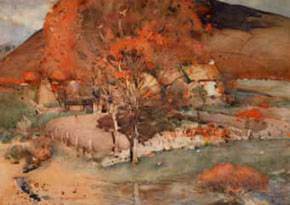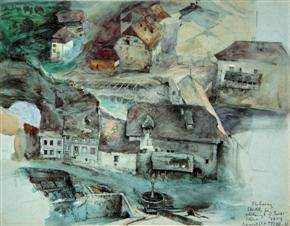
Arthur Melville
Brig o’Turk, 1893
Watercolour, 60.8 x 86.4 cm. The Robertson Collection, Orkney. Photo The Robertson Collection, Orkney
Pioneering Painters: The Glasgow Boys 1880 – 1900, at the Royal Academy In October 2010 the Royal Academy of Arts present the first exhibition in London for over 40 years to celebrate the achievement of the Glasgow Boys, the loosely knit group of young painters who created a stir at home and abroad in the final decades of the nineteenth century
30 October 2010 – 23 January 2011
]]>
Source: Royal Academy of Arts
Theexhibition will feature over 80 oil paintings, watercolours and pastels from public and privatecollections by such artists as Guthrie, Lavery, Melville, Crawhall, Walton, Henry and Hornel.Together they presented a new art, which had a major impact at home and abroad in the closingdecades of the nineteenth century. The resultant works were, from c. 1880 to 1900, among themost experimental and ambitious to be produced in the UK.
Taking inspiration from such French Naturalist painters as Bastien-Lepage and also fromWhistler, the Glasgow Boys produced some of the most revolutionary painting in Britain,drawing praise in London, Munich, Vienna and further afield. Their symbolist pictures wereadmired and emulated in secessionist circles in Germany and Austria.
The exhibition maps the Glasgow Boys’ responses in both subject matter and technique todevelopments in art which were taking place in Paris in the 1870s and 1880s. These artistssought to liberate their art from the staid, dark toned narrative paintings being produced inGlasgow and Edinburgh in order to explore the effects of realist subject matter and the particulareffects of light captured through working out of doors, directly in front of the motif.
The subject matter of the works is largely scenes from rural – mainly Scottish – life, includingstudies of individual figures, such as James Guthrie, To Pastures New (1882–3) and The Hind’sDaughter (1883), George Henry, Noon (1885) and Edward Arthur Walton, A BerwickshireFieldworker (1884). Landscapes include the striking Autumn in Glencairn (1887) by JamesPaterson and A Galloway Landscape (1889), by George Henry. A significant group of works alsorecord modern urban life, including John Lavery, The Tennis Party (1885) and William Kennedy,Stirling Station (1887). Another group shows the impact on artists such as John Lavery, WilliamKennedy and Arthur Melville of their experience of working in France at Grez-sur-Loing, apicturesque village to the southeast of Paris which attracted an international community ofartists. The exhibition closes with a section presenting the legacy of the Glasgow Boys in theearly twentieth century as it was defined by only a few of the members of the group, notablyLavery and Guthrie as portraitists, and by the short-lived Melville, who was a supremeexperimenter in image making and technique, both oil and watercolour.
Follow us on:

